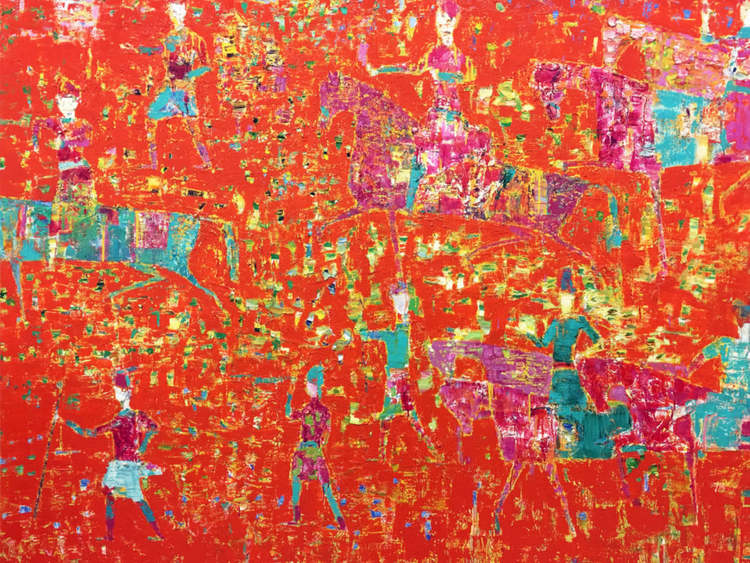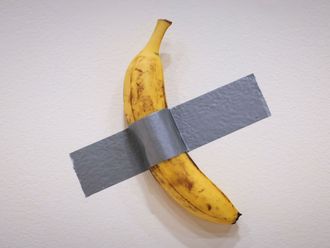Austin, Texas and its population of 9.5 million, is ranked by Forbes magazine as the Next Biggest Boom Town in the United States. With its skyscrapers and showy shopping malls, it is far removed from Sangsar, a village in northern Iran, on the slopes of the Alborz mountains.
Austin is where Iranian-American artist, musician and poet Reza Derakshani has his studio but it was in the mountains in Iran that he grew up. His family led a nomadic existence amidst fields of horses and blue and yellow flowers and he slept in a tent with holes through which moonlight flickered to create ‘constellations.’
The intensity of those childhood years in the 1950s provided the bed rock for his work — but it was the legacy of the great Persian traditions of miniature paintings, carpet making, poetry and music which inspired his oil paintings — luminous in silvers, golds and reds.
Hunting the Light, Sophia Contemporary’s second presentation of paintings by Reza Derakshani, draws on the hunting scenes which were popular in the Royal Court of the Safavids who ruled from 1501 to 1722.
The Persian miniatures were characterised by bright, pure colouring and exquisite detail. The artist would use a brush the width of a single hair to produce his masterpiece but Derakshani has a bolder, bigger canvas, his lavish oils summoning up spectral figures and their steeds which shimmer out of a blue or a green background. In Hunting Red, the hunters are like ghosts of the past against a blaze of crimson.
Other works are from his Garden Party series which portray families, rich and poor alike, gathering under tents and canopies to feast in gardens which were regarded in Persian culture as metaphors for heaven and the afterlife.
Similarly, he draws on the tragic, romantic tale of two lovers — the Persian prince Khosrow and the Armenian princess Shirin, who lived in the 6th century AD. The story, which some believe to be the inspiration for Shakespeare’s Romeo and Juliet was first told in the Shanameh, the Book of Kings, and it is the writings of the past and the poetry of Hafez and Rumi in the 14th and 13th centuries that kindle the imagination of the artist today. Derakshani’s depiction of the prince chancing upon the bathing maiden can be compared directly to the illustrations of the 12th century.
But to talk about Derakshani’s work only in reference to the past is to miss the inevitable influences of his leaving his homeland for a self-imposed exile.
Like many Iranian artists, he quit the country in 1983 following the Islamic revolution of 1979 and went to New York where he lived for 16 years. He had not seen an original masterpiece until art school in the 1970s, when the Tehran Contemporary Art Museum opened. He saw works of Willem de Kooning, Jackson Pollock and Francis Bacon but now he was plunged into the heady world of Abstract Expressionism and rubbing shoulders with fellow artists and friends such as Francesco Clemente, Shirin Neshat and Cy Twombly.
The influence is evident in works such as Garden Party at the Red Castle with its dramatic burst of colours or Red Dance at the Blue Party in which the figures, stretched and blurred are hard to decipher in the splashes of colour.
Abstract art, however, did not prove satisfying enough for the artist. Life as a nomad had not blunted his sense of country and culture and he reconnected to his Iranian roots by blending abstract and figurative elements drawn from both eastern and western cultures.
The artist was not available for an interview for the opening of the show but previously he explained: “I think the more you know about different styles and ways of working, the richer the work gets. I don’t like to be categorised in a certain way as a Middle Eastern artist, as a painter, as only an abstract artist or only figurative artist. It’s a big world. You don’t want to define yourself too narrowly and get stuck.
“Art is about liberties. It’s about the mind and senses flowing and discovering. It’s a universe by itself. I cannot imagine being forced to just do one thing, as the market dictates. That’s probably one reason I’m not good in galleries. They mostly want you to stick to your ‘thing’ because of the market.”
The market has warmed to his work; attracting six figure sums at Christie’s and Sotheby’s and selling between £45,000 (Dh231,000) to £75,000 at the Sophia Gallery.
From New York, Derakshani moved to Italy and back to Iran for seven years in the early 2000s only to find the country had changed so much that he could not relate to it. He left in 2009, never to return.
“Things got a little bit awkward,” he recalled. “There had been the Arab Spring in Tehran a couple of years before that. There was a rise of fundamentalists and that affected you one way or another, especially for someone who lived a couple of decades outside of that society. There were times where I felt like I didn’t belong to the country anymore: I couldn’t connect to the people around me; I could not understand them; they could not understand me. It was a different world. I personally got some bad vibes and some poking, so I thought, ‘I can’t work anymore. I can’t concentrate.’ I decided to leave immediately... kind of run away. Dubai was close so I thought, I’ll go there.” He still owns a property in the UAE.
Second time around, he found himself once more in New York but it was the middle of winter and he was sick, so he visited a friend in Austin where he was bowled over by the beautiful sunny skies.
“I found it interesting and relaxing and the people were nice,” he says. “I found this amazing property as if it was built for me, so I said, ‘Why not? Let’s try and see if it works or not’.”
For all the bad vibes and the enforced exile, one of the striking features of his work is that most of it is rarely angry or judgmental. He appears to evince no outrage at the regime in Iran, instead his paintings are about the aesthetic style and technique — often light, bright and accessible.
As Norman Rosenthal, former Exhibitions Secretary of the Royal Academy of Arts in London, wrote in a catalogue for an exhibition in 2016: “We can interpret his hunting paintings as statements of luxurious beauty that has always infused the art of Iran, even if many Iranian artists today understandably also wish to face other realities. But this does not negate the value of the search for the dreams of past times and even strivings for a possible romantic present.”
Derakshani would be the first to admit his work is almost all improvised, which makes his abstractions hard to understand, yet there is a beauty to most of his work which is untrammelled by gimmicks, photomontage or videos. He has broken away from painting to create sculptures — large-scale outdoor pieces, very abstract using metal, glass, plastic and some unusual material but these are rarely exhibited, if at all.
Some of his most striking works, very different from the Hunting paintings, appear in the series titled Identity Crisis. These are dark and mysterious, almost threatening, and could be easily be mistaken as works by another artist just as Black Water which salutes female singers who were victimised and banned by the revolutionary regime.
He recalled: “It started when I bought a massive pack of old records of Persian music at the Friday market. The covers showed dozens of female singers from before the Revolution. I almost cried; both for the loss of female voices which can longer be heard publicly and for the theft of their freedom of expression. I investigated the loss of this freedom, the obliteration of character, vanishing beauty and the loss of precious human connections because of religious and political dictates.
“But because of what happened, they either had to flee the country or be in exile. They all lost their lives, their status as performers. Some had tragic endings. That inspiration is always with me. Philosophically, there is a strong force against any kind of beautiful, joyful thing that improves life, and I couldn’t take that,” he said.
Perhaps too he has fierce feelings for these lost singers because his first love was music.
“I used to sing when I was a kid. It was natural. I had a voice and a passion for music. I remember doing outdoor theatre during religious festivals. I always wanted to learn instruments but never had the chance until I got to college. I practiced two hours every day in the morning. I never thought I was going to do it professionally, but when I left Iran, I was in Rome and a club asked me to do a concert. It was my first public performance.
“For a few years in New York actually, I did more music than painting. It was more convenient because it was just me and my instrument. Now the focus is on art but the music is coming back.”
His most productive partnership developed when he was invited to do a concert in New York with John Densmore, the drummer from the legendary 1960s band, The Doors.
His music is improvised, abstract, with layers upon layers, not unlike the paintings but here again tradition has a hold. He is adept at the guitar but the instruments he plays alongside Densmore include the Persian stringed tar, and the ney — a flute which has been played continuously for 5,000 years.
He readily acknowledges that Persian miniaturists and carpet makers with their vivid representations of hunting, love and garden parties, could have been an influence on his music and vice versa.
“It is very emotional,” he said. “I would make myself cry playing. Gradually, the music changed and found a new form and my painting looked back to the traditions, so they met halfway. It was more peaceful.”
Richard Holledge is a writer based in London.
Hunting the Light will run at the Sophia Gallery, Mayfair, London, through March 10.

















